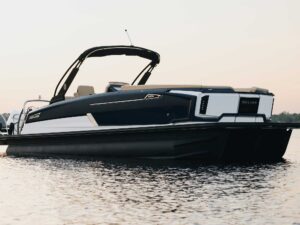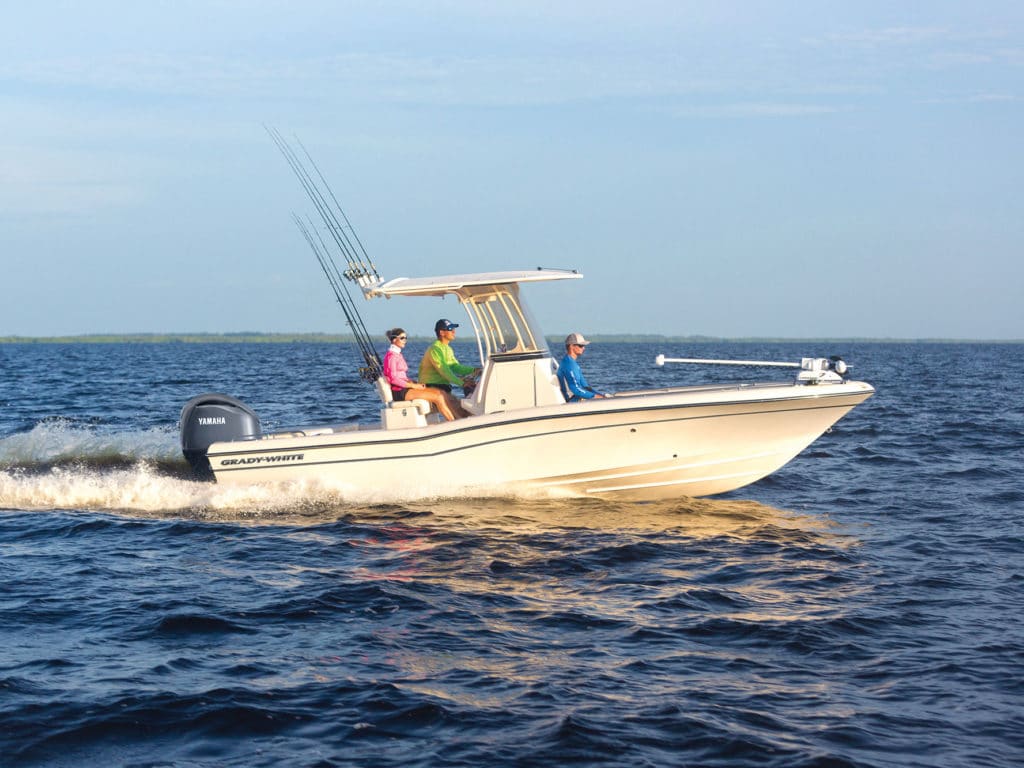
Coastal anglers typically have a lot of variety when it comes to fishing grounds. Some love the flats and backwaters, skinny waters that often require a flats boat with less than 12 inches of draft to access. Others prefer the more open waters of bays, inlets and nearshore areas just off the beach or within a few miles of shore, the hunting grounds of the classic bay boat. And then there are those who want the coastal trifecta. Fish the flats on occasion, enjoy all that the bays and inlets have to offer, and confidently head to the blue water offshore when conditions are right. Enter the hybrid, a relatively new variation on the theme that attempts to do it all—like a bay boat on steroids.
How do these types of boats compare? And which style best suits you, your waters and your fishing habits? Spoiler alert: There’s plenty of crossover between the categories. But to help, we’ve assembled what we think is an above-average example of each type of craft. Compare and contrast to find the right fit for you.
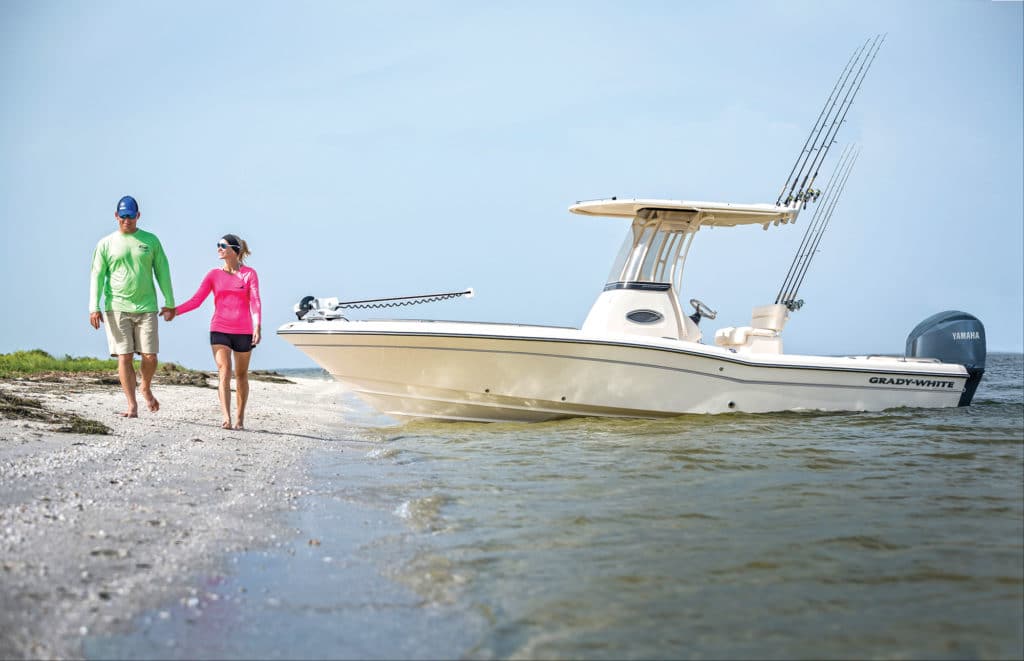
Hybrid: Grady-White 251 Coastal Explorer
Definitions of a hybrid can skew in one direction or the other, but the common denominator will always be that a hybrid is a bay boat that can, when conditions beckon, confidently venture offshore. That describes Grady-White’s 251 Coastal Explorer pretty much to a T. As always, hull design makes it possible. Grady-White’s SeaV2 hull features a continually variable deadrise, starting with a sharp forward entry before flaring to as much as 30 degrees amidships. But its secret sauce is that it softens to a mere 16 degrees at the transom. At rest or trolling speeds, minimum draft defies expectation at a mere 14 inches. It’s a combination that, in conjunction with an abundance of bow flare and a 20-inch cockpit depth aft, lets the 251 more than hold its own in sloppy offshore conditions yet still sneak into skinny flats and backwaters.
Topside features likewise combine the best of both worlds while acknowledging that the boat will also likely see considerable family duty. Forward, a sizable casting deck includes port and starboard 74-quart fish boxes below flush-hinged hatches, as well as a trio of vertical rod holders on each side to keep go-to rods at the ready. Underneath the console seat awaits 74 quarts of insulated storage. Behind the console, a leaning post with a backrest includes more rod holders, with a 25-gallon livewell that conveniently opens from the side for easier access. An aft casting platform adds a 12.75-gallon livewell center, along with port and starboard fish boxes. Add cushions to both decks for family comfort. Unique touches include the removable center insert in the bow platform that can be placed in front of the console seat to form a kick-your-feet-up recliner. Or raise it to create a table, all without impeding a passing angler’s movement. Port and starboard fish-box cushions, both fore and aft, also pivot upward to form forward-facing backrests with a comfortable angle of recline. The bow and stern both feature boarding ladders, easing passengers on and off the bow when beached or out of the water.
Other features of note include a streamlined T-top that integrates into the console rather than impeding on deck space; full wraparound glass on the console for better visibility and wind protection; and a console compartment deep enough to stow plenty of gear or realistically use as a head. Lower gunwale heights (about 20 inches) also deserve mention. They’re high enough to provide protection and security offshore, yet low enough to make it easier to get your catch in and out of the boat. And then, of course, there’s Grady-White’s quality. The 251 is completely self-bailing. Every livewell, fish box, and even cleat and cup holder ultimately drains overboard, not just to the bilge, meaning no mechanical pumps are relied upon to direct water overboard. Like Grady-White’s larger offshore models, the 251 also features enough foam flotation to be unsinkable, comforting knowledge when you trade those skinny waters for what lies outside the inlet.
| LOA: | 24’7″ |
| Beam: | 8’6″ |
| Draft (min.): | 1’2″ |
| Transom Deadrise: | 16 degrees |
| Dry Weight: | 3,715 lb. (without engine) |
| Seat/Weight Capacity: | 10/2,800 lb. |
| Fuel Capacity: | 78 gal. |
| Available Power: | Single outboard to 300 hp |
| Price: | Not available at press time |
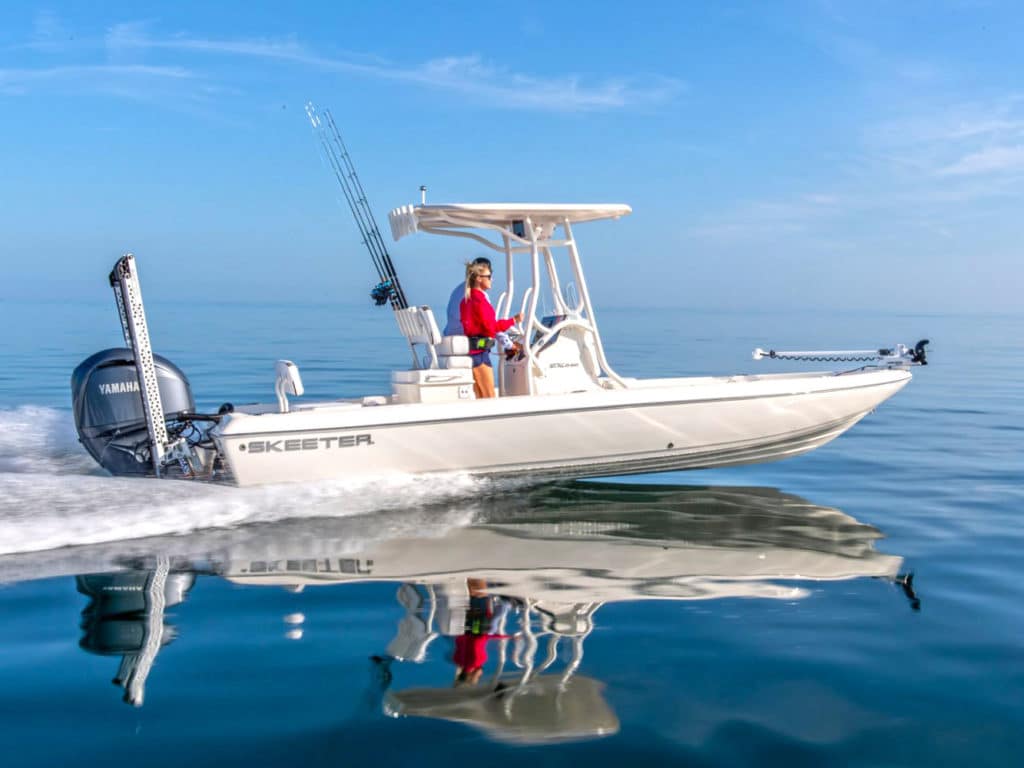
Bay: Skeeter SX240
Bay boats such as Skeeter’s SX240 add another level of flexibility for the coastal angler. While its 15-inch draft is still minimal enough to pursue that redfish or spotted seatrout across grass flats or work the perimeter of the mangroves, a 20-degree deep-V hull means the boat is very much at home in deeper bays and nearshore spots, from just off the beach to several miles offshore. That opens up the possibility of going after stripers or bottomfish in big bays, cobia along the beach and, depending on the season, snapper, jack crevalle and even king mackerel in nearshore waters. A bay boat is also often a good alternative for the shallow-water enthusiast who has to frequently run through larger, open waters to reach their favorite skinny spots.
At 24 feet, 1 inch, the SX240’s bigger-water size also works with a larger crew and increased gear. Its center-console design allows anglers to work the entire perimeter with ease. Gunwales are higher than on a flats boat for greater security and comfort in larger waves, but still low enough to easily bring a fish up and over the side or lean down to take out a hook. That lower profile also catches less wind when using a trolling motor. And storage is in abundance, with rod and gear lockers ready to stash items away and keep the deck free for the task at hand.
While a flats boat might have only a forward casting deck, bay boats will typically feature a second at the stern. Skeeter’s spacious forward deck is raised for better visibility, but designers acknowledge the height by adding steps to ease access. Compartments built into the deck include a rod locker to
port and an insulated fish box to starboard, a solution that keeps the insulated cooler clean for drinks and snacks. An oversize anchor locker is ready for the anchor and rode, and includes an access hatch to get below the optional trolling motor. Skinny-water anglers will want to add it. Other compartments stow both wet and dry gear. A unique touch: Compartment interiors are made of roto-molded plastic rather than gelcoated. It’s more durable and won’t chip. A 14-gallon livewell is found nestled below the forward console seat.
Like most center-console designs, it’s easy to work around the boat’s entire perimeter. A deluxe leaning post adds rocket launchers, great for keeping multiple rods at the ready. More are found atop the T-top (a feature almost never found on a flats boat), which adds welcome sun protection. Aft, jump seats straddle a 40-gallon livewell. Use it to keep the majority of your bait healthy on the run out, then transfer what you need forward when it’s time for lures to hit the water. Additional compartments on this boat include designated wet storage, perfect for keeping a cast net separate from other items. Consider a trio of options: upgrading the standard jack plate to hydraulic, adding trim tabs for a better ride, and adding Power-Pole anchors to quickly set up in prime shallow-water fishing spots.
| LOA: | 24’1″ |
| Beam: | 8’5″ |
| Draft (min.): | 1’3″ |
| Transom Deadrise: | 20 degrees |
| Dry Weight: | 2,925 lb. (without engine) |
| Seat/Weight Capacity: | 8/1,096 lb. |
| Fuel Capacity: | 75 gal. |
| Available Power: | Single outboard to 300 hp |
| Price: | $84,540 |
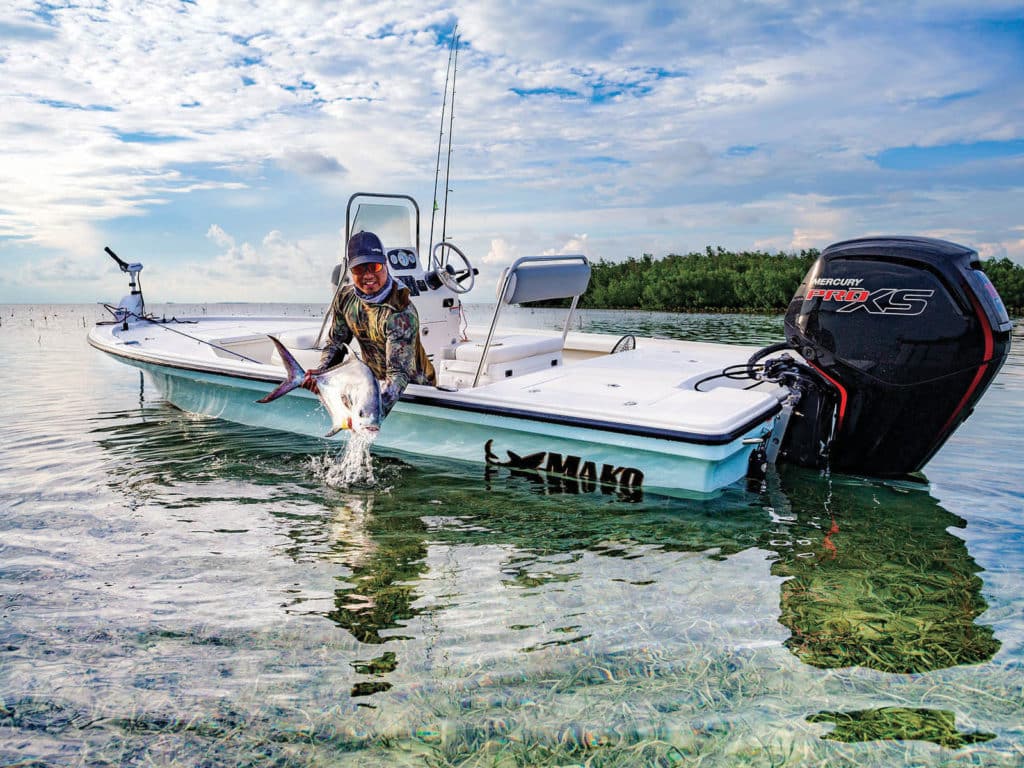
Flats: Mako 18 LTS
With a shallow 13-degree deadrise and minimal 11 inches of draft, the 18-foot-6-inch Mako 18 LTS epitomizes the hull design of the classic flats boat. It’s ready to take anglers into super-skinny coastal waters, like those flats, salt marshes and tidal creeks that are home to popular gamefish like snook, permit, bonefish, striped bass and tarpon. Its Rapid Planing System (RPS) hull is exceptionally stable for such a minimal-draft hull at rest, but designed to jump quickly onto plane, essential when running in shallower waters. Shallower-deadrise hulls also typically boost top speed, allowing for the use of smaller, lighter and more fuel-efficient outboards. A shallow tunnel in the hull directly in front of the motor’s gear case is designed to maximize cooling-water flow to a trimmed-out engine or one raised using the typically optional jack plate that allows for even shallower running. Mako eliminates lifting strakes around the perimeter of the hull for reduced drag. Flats-boat designers also often use rolled chines or design chines and strakes to be either above or below the water at rest to minimize hull slap when poling across flats, allowing the boat to glide more quietly and sneak up on its prey.
Since skinny-water anglers primarily cast rather than troll, flats-boat designers typically prioritize a large casting deck forward, nearly flush with the gunwales, featuring a nonslip finish. On the Mako, that bow deck includes angled wings at the aft corners to create additional space to move aft. The deck and grippy nonslip surface texture continue down the port and starboard sides before connecting into another casting deck aft, the latter being a bonus in this category. All the mainstays are accounted for, including a trio of rod holders built into each side of the low-slung center console to ensure rods are always at the ready, an 18-gallon combination livewell/release well tucked away below the seat in front of the center console, and additional rod storage under the gunwales to port and starboard, ideal for those longer fly rods. A Minn Kota trolling motor comes standard to quietly maneuver the boat’s intended waters. Consider the optional raised poling platform over the motor. It offers greater leverage as well as added visibility to tip off those on the forward casting deck where to direct their lure.
Extras include the leaning post on the Mako based around a large 72-quart cooler ready to stock with drinks and snacks or put a catch on ice. The pivoting backrest can face forward for driving or backward to kick back with feet up on the aft platform. Multiple storage compartments with flush, stub- and snag-free hatches and hinges are located on both fore and aft platforms, with finished gelcoated interiors and locks to secure contents.
| LOA: | 18’6″ |
| Beam: | 7’7″ |
| Draft (min.): | 11″ |
| Transom Deadrise: | 13 degrees |
| Dry Weight: | 1,755 lb. (without engine) |
| Seat/Weight Capacity: | 5/610 lb. |
| Fuel Capacity: | 28 gal. |
| Available Power: | Single outboard to 115 hp |
| Price: | $34,995 (with Mercury 115 and trailer) |
Read Next: Boat Console: Center Versus Dual
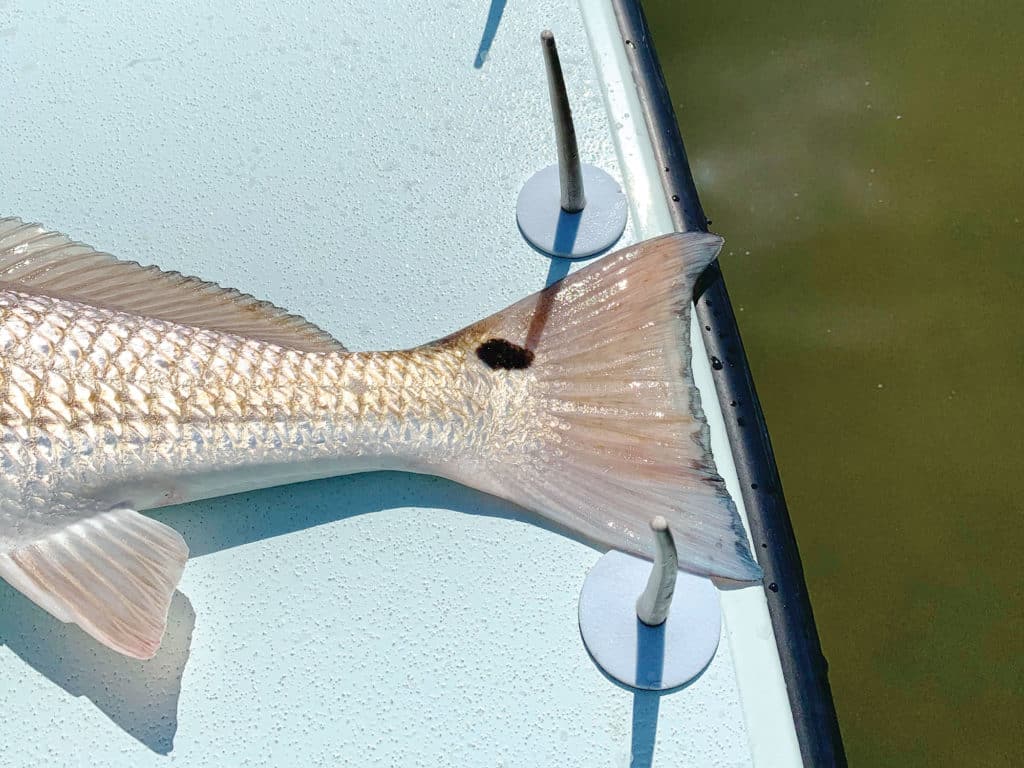
Spike It
If you see a flats, bay or hybrid boat with vertical spikes on the gunwale encircling the forward deck, you might wonder about the purpose of these. They are line-management devices for fly-fishing. Made of rubber by Tampa, Florida-based Carbon Marine, they stick to any flat surface to help prevent excess fly line on the deck from spilling overboard or tangling in an unwieldy bird’s nest. To learn more, visit carbonmarine.com —Jim Hendricks

